Don't wanna be here? Send us removal request.
Text
5. Experiencing religious diversity in Paris
Experiencing the world's religious diversity is something that has been new to me since freshman year of college. In high school, I definitely learned about other religions, but it wasn't until college that I actually experienced them. Hope College has a program called Phelps Scholars that encourages learning about diversity and how we can celebrate our differences. Through this program, I learned more about Catholicism and Islam. Because of this program, I had already visited a mosque, so that experience in Paris was not new to me (although the mosaics and gardens in the Paris mosque were new and they were a delight to see), but attending the mass was a new experience for me.


I grew up in modern Christian churches, and identify myself as a Christian today. I never had any Catholic family or close friends, so I had never attended a mass. I wouldn't recommend going to mass for the first time in a country that speaks a different language - you'll probably be very confused, and I'm speaking from experience.


While I had no idea what the priest was saying throughout the service, I was still able to feel an emotional connection through the music. Music is an important part of my faith. Singing worship songs has been a part of my life ever since I was little. Even though I'm not a talented singer, I've always felt spiritually moved during worship. So, you can imagine what it was like for me to be in a space that was designed and built specifically to amplify sound. Unfortunately, I was near a speaker so I didn't get the true experience, but I was still brought close to tears by the choir's performance.
Something I have come to realize over the years is that I love learning about other people. It was so interesting to learn about how the mosaics at the mosque represented Paradise and how their gardens had to be built and organized in a certain way. I saw people going to church at mass and wondered how many were curious tourists like me and how many practiced the Catholic faith. We were all created to be beautifully unique, but we also all have so many similarities. I was able to see diverse groups of people living together in one city, something that definitely does not happen in Holland.
I am happy that I stepped out of my comfort zone and had this wonderful opportunity to see more of the beautiful world God created.
0 notes
Text
4. Pere Lachaise Cemetery
At first, I wasn't particularly excited for this visit. Cemeteries have never been one of my favorite places to be and there wasn't a specific celebrity grave that I wanted to see, but in the end I was surprised to find that I was happy I went.


Pere Lachaise spans over 99 acres, making it the largest cemetery in Paris. There are spaces for 70,000 burials. The graves are cramped together, making it difficult to walk through the middle of a specific area. The lands where the cemetery resides were originally owned by Jesuits, but they were expelled from France in 1763 and the city of Paris bought the lands and turned it into a cemetery. It wasn't until 1817 when the graves of some well-known people such as La Fontaine and Abelard and Heloise were moved to Pere Lachaise that it became a popular site for Parisians to visit. The cemetery was named after Father La Chaise, who was a generous benefactor when the land was still owned by Jesuits. Today, the cemetery is home to the final resting places of Jim Morrison, Gertrude Stein, Edith Piaf, Oscar Wilde, and a large amount of other famous people.



I was struck by the wide variety in graves there. They ranged from what looked like mini versions of churches to simple headstones. There was also a range in the times people lived. There were some graves of people who died in the past ten years, but there were also graves covered in moss whose dates had long been erased by the passage of time. There was a variety in the culture of the people who are buried there. I saw graves celebrating the lives of Asian and Jewish people.


As I said before, there wasn't any grave in particular that I wanted to see, so I decided to stick with Gertrude Stein, who was a wealthy benefactor for artists like Picasso and Matisse in the early 1900s. Of course, her grave was on the opposite side of the cemetery from the main entrance, so I had a long trek across cobblestones and up stairs and hills. Once I got over the initial creepiness of being in a cemetery, I found the space to be remarkably peaceful and, ironically, alive. Over 3,000 trees are spread out over the area, providing beautiful greenery to look at. Birds sing in the trees, bugs buzz around your head, and you can hear children playing in a nearby park. I rarely came across other people, so I was able to enjoy the piece and quiet.

I finally made it to Stein's grave, but stepped out of the way for a tour group after taking this picture. I wandered over to the nearby memorials. My interest was captured by several sculptures of skeletal men, and found these to be memorials for those killed in Nazi concentration camps.

It was an emotional moment for me, as I remembered I was in an area where people were directly affected by the inhumane actions of the Nazis, no longer an ocean away from it.

I was most affected by the memorial for the children killed (pictured above). The small outlines portrayed a curious and innocent spirit.
You may notice small stones on these memorials. This is a tradition in Jewish culture. One explanation for this custom is that stones don't die and are more permanent than flowers, and represent how the memory of that person goes on. Another explanation is that they "keep the soul down", as some believe that the soul of a person temporarily stays in the grave in which they are buried. You will also see these stones on Gertrude Stein's grave since she was born into a Jewish family.
While I did walk away from this experience a little more sad than before I came to the cemetery, I am glad that I came and experienced it.
Sources: Michelin Green Guide Paris, https://jwa.org/encyclopedia/article/stein-gertrude , https://www.jewishvirtuallibrary.org/putting-stones-on-jewish-graves
1 note
·
View note
Text
Group Clovis Final
In a very Parisian way to finish the 2022 Art History May Term, our final exam involved navigating the streets of Paris in groups of three students. After being handed the sites to visit, our group formed a route based on arrondissements and distance between each site. Starting at Jardin des Tuileries, we first hopped on the nearest metro and landed in the 5th arrondissement, where we found our first point of interest. “L’arbre des Rues” was a diamond in the rough, as the unassuming wall made the poem and the massive mural easy to miss (especially for our group at first). Though the poem was in French, the mural depicting a tree gave us insight into the overall message. After finding digital works of artist Pierre Alachinsky through the Centre Pompidou, we discovered that he seems to show a vested interest in mixing nature and civilization through his work. Though Alachinsky was well known for his Painting inspired by Central Park, seeing the mural reminded us of just how unique Paris is in terms of widespread urban parks and natural areas.

Our second stop took the group to our namesake, Rue Clovis. Perpendicular to the mural, Rue Clovis is in the heart of the 5ème arrondissement. The group immediately observed the status of the area as a student district, as institutions such as the Sorbonne and the City University of Paris seemed to own many of the buildings in the area.
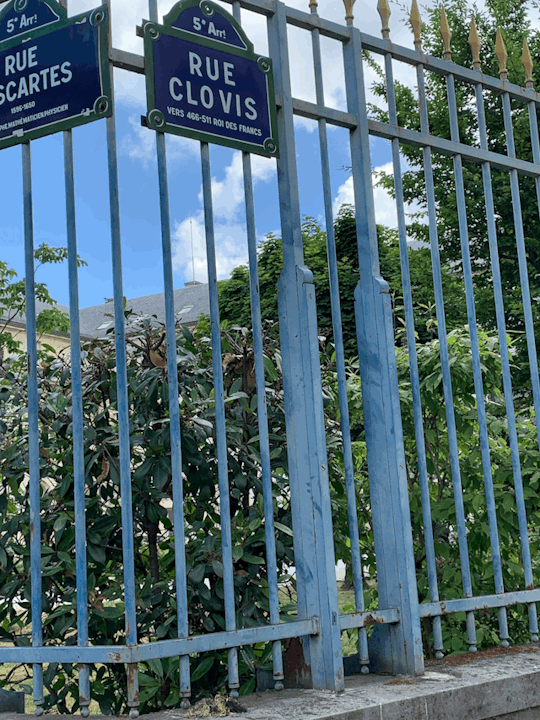
Our third point of interest in the nearby 6ème arrondissement was within walking distance, taking the group by Luxembourg Gardens and various upscale restaurants and shops. Saint Sulpice church was a puzzling sight from the outside, as the construction nearly led us to believe it was closed; however, the Delacroix murals inside challenged us to realize the church’s significance in Paris, despite its relatively unknown origins. The murals Jacob Wrestling with the Angel and Heliodorus Driven from the Temple were directly across from each other on walls. Considering that the murals were painted by an incredibly well known artist, it was surprising that they were relatively tucked away and hidden from the entrance. The murals were incredibly significant in terms of Eugene Delacroix’s artistic legacy, as the National Delacroix Museum noted that the murals were one of his last works.
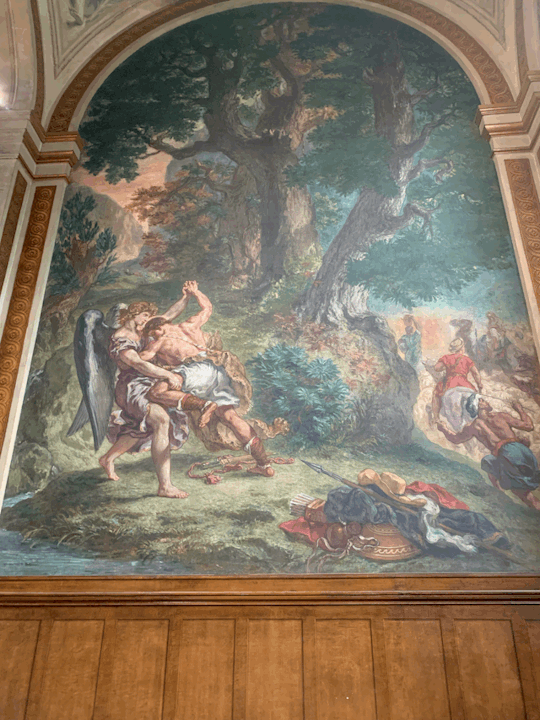
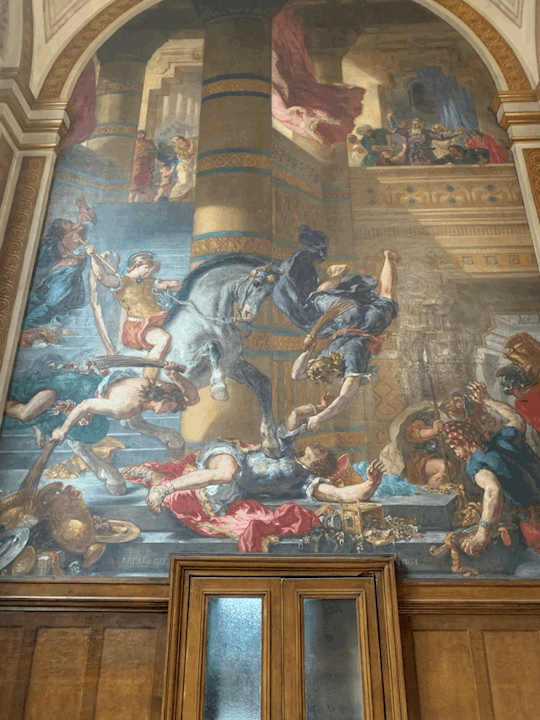
The next point of interest was Église Saint Germain des Près, and it was also walking distance as it is in the 6ème as well. This church seemed to be much more well known than the Saint Sulpice, and it was a familiar name after frequenting the metro in these past few weeks. Seeing the church on the outside raised questions about the age, as we had no clue considering the architectural detail. After reading that it was built in 543 AD (making it the oldest church in Paris), there was a sense of collective shock that the church withstood over a thousand years of wars and development.

Our next location, Pont Alexandre III, is probably one of the most visually dramatic bridges. At each end there are two bright golden statues of Alexander III, the man who laid the foundation stone for the bridge. It serves as a guide to Les Invalides, now an Army Museum and the final resting place for Napoleon. The bridge was built in 1900 and shows off France’s power and wealth.

Once the place of execution by guillotine during the French Revolution, our next stop, the Place de la Concorde, is now a busy roundabout with an obelisk in the center. There are eight statues that surround this obelisk, each representing a different city in France. We visited the Brest statue, which was a woman holding an object that seemed to look like a harp of some sort.
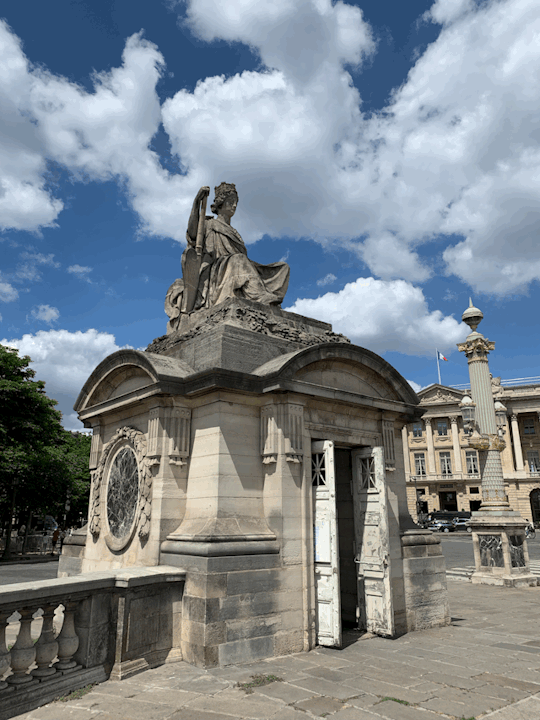
Our next stop was Musee de l’Homme, which translates pretty directly to the museum of mankind, an anthropology museum in the 16th district. The first thing we noticed when we got out of our metro station was the cool view of the Eiffel Tower just to the left of the building. The museum looked relatively small in comparison to some of the massive ones we have visited thus far, but we all agreed that the content looked quite interesting and something to check out either before we leave or the next time we are back.
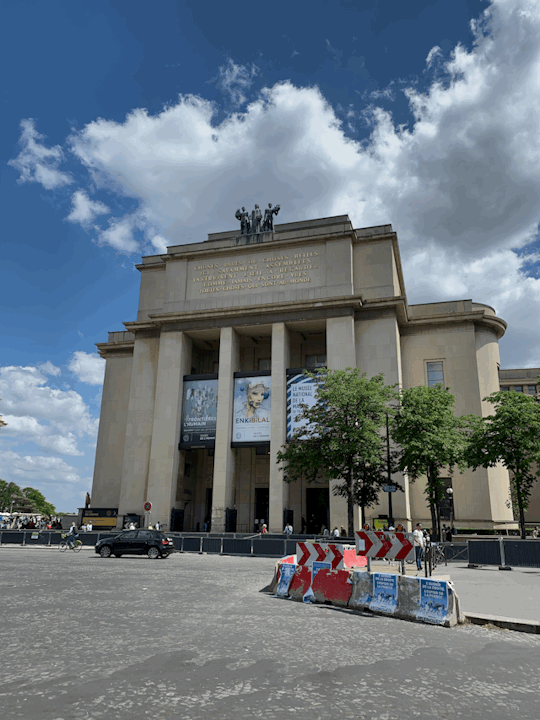
After this, we took a pretty hefty metro ride to get to the Pont tournament de la Grange aux Belles, also known as the turning bridge. We weren’t all too certain of what to expect, especially given that most of the bridges we have walked along thus far have been large and ornate, some containing locks all over the sides. When we arrived, we were pleasantly surprised at how small and unassuming the bridge was. We found it to be a lot more personal than some of the other bridges we have walked on the trip. It also had a pretty cool view of the neighborhood it was surrounded by, which we agreed is an aspect of Paris we have really enjoyed.

It was no easy trek to get to our next stop, the Temple of the Sibyl. The park surrounding this temple is large and beautiful, but also very hilly, and the temple was at the very top; we definitely got a good workout. Unfortunately, due to erosion and safety issues, the temple was closed off, but we were still able to see the lovely view of the trees in the area and the city in the distance. The temple was designed based off of a Roman temple. The Sibyl was a figure in Greek and Roman mythology (usually female) who told prophecies. Although this was a bit of a hike to get to, the views were amazing and it was an excellent spot to finish off our final expedition!
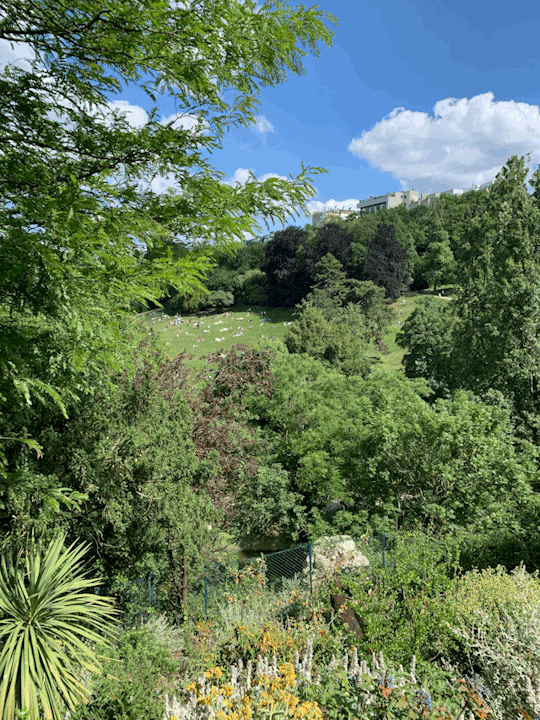
Sources:
https://www.hotel-de-la-marine.paris/en/The-Hotel-de-la-Marine/Place-de-la-Concorde/history-place-concorde
Michelin Green Guide Paris
2 notes
·
View notes
Text
3. Musée national des arts asiatiques, Guimet
Yeah, I know, that's a really long name for a museum. It translates to the National Museum of Asian Art, but it can also be called the Guimet Museum. The museum gets its name from its founder, a French industrialist named Émile Guimet. He intended to create a collection of Egyptian and Asian religious pieces with items that travelers such as Charles Varat and Louis Delaporte brought back from Asian countries. The Louvre began building its own collection of items from Asia, and in 1945, the two museums made a swap: the Louvre received Guimet's Egyptian pieces, and Guimet received all of the Louvre's Asian art. Now, the Guimet Museum was one of the world's first Asian art museums. It includes art from India, China, Japan, Korea, Afghanistan and Pakistan, Cambodia, and other Asian countries.
Walking in to the museum, I felt very overwhelmed. I forgot to look for a museum guide and couldn't find one after my ticket had been scanned. When you first walk in, you are instantly greeted by hundreds of carved stone statues of bodies and heads, which seemed to mostly represent figures from Hinduism and Buddhism. Near the stairs, I found a sign pointing downstairs to the temporary exhibit, so I decided to start my museum visit by checking that out.
I was delighted to find out that the exhibit, titled L’arc et le sabre. Imaginaire guerrier du Japon, was about Japanese Samurais. I didn't know much about these ancient warriors and was excited to learn more.


The exhibit was set up in a way that I found to be very interesting. Most of the time, in art museums, each room is a bright open space with white walls and very good lighting. Here, all the walls were black, with the pieces set up in glass cases that either had white or black walls and dramatic lighting (as seen in the pictures above). I enjoyed this different presentation and think it emphasized the honor and strength that each Samurai found in their position.

The pieces in this exhibit showcased the weapons and armor of the Samurai, but it mostly emphasized how they were represented in art throughout Japanese history. They became popular characters in Japanese theatre, represented by both people and elaborate puppets. Theatre in Japanese culture was no small feat; it included ornate make-up and costumes, and the performances by each actor were nothing less than extraordinary.

The Samurai are also represented in a variety of prints, which are occasionally used to tell specific stories. The tale of the 47 ronin is one of these stories. It is about a group of samurai whose lord/master was forced to commit seppuku (suicide by disembowelment) after attacking the master of ceremonies in the shogun's palace. These samurai, who were called "ronin" after their master died, sought revenge and killed the master of ceremonies, which lead to them being forced to die in the same way as their master. It is a story that revolves around loyalty and questions to whom one's loyalty is owed.


Today, the Samurai have become influential in a variety of media, including Japanese comics (called manga). They have also become inspirations for Western media, such as Star Wars and Power Rangers.
Of course, this exhibit didn't last forever, and I had to move on to other parts of the museum. There are five floors and each one is divided into sections by country. After wandering through many, many stone statues (each one exquisitely carved and detailed) I found my way to the second floor, where I found the museum's vast collection of Chinese ceramics. The museum holds over 20,000 pieces of Chinese art, and around 10,000 of those pieces are ceramics. Each piece was beautiful and I was amazed at the detail on each and every one.



Throughout the museum, there were three pieces of red tape that guided you to specific pieces, all of them being contemporary sculptures by the Japanese artist, Chiharu Shiota. Unfortunately, because of the cursed ten picture limit, I can only show you one of these pieces, but it's my favorite of the three.

This piece is called "Living Inside" and represents both confinement and connection. It was inspired by the COVID lockdown in 2020. The miniatures are all contained within this web of red thread, none of them touching each other directly, but connected by the thread. At the top of the piece (not pictured above), a large net covers the ceiling.
I absolutely loved this piece and was so happy I was able to see it. As someone who also uses yarn, webs, and nets in my own artwork, I was so excited to see another artist use the material and read about how they used it. Her message came across very clearly and it was an excellent use of the space she was given, contrasting the large buildings and architecture outside to the small dollhouse furniture inside.
Overall, this museum was a great experience. If I'm ever back in Paris again, I would love to return here to discover new exhibits and look closer at the ceramics and prints.
Sources: Michelin Green Guide Paris, and https://www.guimet.fr/musee-guimet/histoire-du-musee-guimet-2/
0 notes
Text
2. Jardins des Plantes
I believe I have found one of my favorite spots in Paris. The Jardins des Plantes is a gorgeous space in the 5th arrondissement, just a 20 minute walk from our hotel!

Before going on and on about how beautiful the area is, here's a bit of history: In 1626, two of the king's physicians were allowed to put the Royal Medicinal Herb Garden in the St. Victor district. This garden grew to become a school, and in 1640, it was opened to the public. The space flourished during the time of the curator Georges-Louis Leclerc, Comte de Buffon (meaning Count of Buffon). The Count is known for his research and discoveries in the world of biology, particularly Histoire naturelle, a work spanning 36 volumes in which he attempted to gather all known research concerning Earth's natural history. He acquired more land for the gardens and established the natural history museum that still stands there today. He also placed a small Labyrinthe with a small gazebo near the museum.


Today, the Jardins des Plantes, has museums, greenhouses, a library, and a zoo. When I walked through, I noticed runners, families, couples, and a few loners, all able to enjoy the wonderful weather in this fantastic space. It is still a space of learning, in addition to the museums, there are also signs that point out the different sorts of plants and plaques describing the history of a certain area or sculpture.


I experienced the area as a place of adventure and discovery. I loved walking around and seeing what I could find. I found the rosary, a lovely area filled with all kinds of different roses and a few sculptures.



I found the Labyrinthe. While it was a simple spiral up to the middle, I did discover a few treats along the way. There are a few paths within the hedges. Whether or not those are intentional, I found them to be a fun path on the way down.
At the very top, in the gazebo, I found a view of the trees and plants surrounding the Labyrinthe.

Unfortunately, I have reached the photo limit for this post, but trust me, the little hidden paths were there.
I amazed by the large amount of green spaces within the city, and the size of those spaces. Because of the cheap public transportation and free entry, they're accessible to anyone and provide a wonderful respite for tourists and citizens.
Sources: The Michelin Paris Green Guide, and http://scihi.org/comte-de-buffon/
0 notes
Text
1. Place des Vosges
Bonjour! Before heading to the wonderful Louvre, a few of us took the opportunity to visit the Place des Vosges, located in Le Marais district in the 4th arrondissement. This is an area that is filled with shops, cafes, boulangeries, and people, all inside beautiful older architecture (some being pre-Revolution).

Once you walk under the buildings pictured above, you come across a lovely square filled with people suntanning, eating, and playing with their kids. Trees in the four corners and the center provide plenty of shade, and slides and see-saws can be found along the edges of the park.
The Place des Vosges is the oldest square in Paris. Originally a place of residence, the Crown came into ownership of the building in 1407. It was torn down by Catherine de Medici and later turned into a square in 1605 by Henri IV. It was called "place Royale" and used frequently for extravagant parties and gatherings. In 1800, after the Revolution, the place was renamed Vosges after an area in France that was the first to their taxes to the newly formed French government.


A towering sculpture of Louis XIII in the middle of the square is the only reminder of royalty left behind. Now, it is no longer a place for only royalty and nobles; it can be enjoyed by anyone. It's a public area that is well-kept and clean. I found it to be a moment of peace and rest in the midst of a busy day. It was wonderful to sit in the shade and listen to the sounds of the fountains and conversations around me. The area is closed off from the sound of traffic, so you can peacefully enjoy your time there.



1 note
·
View note